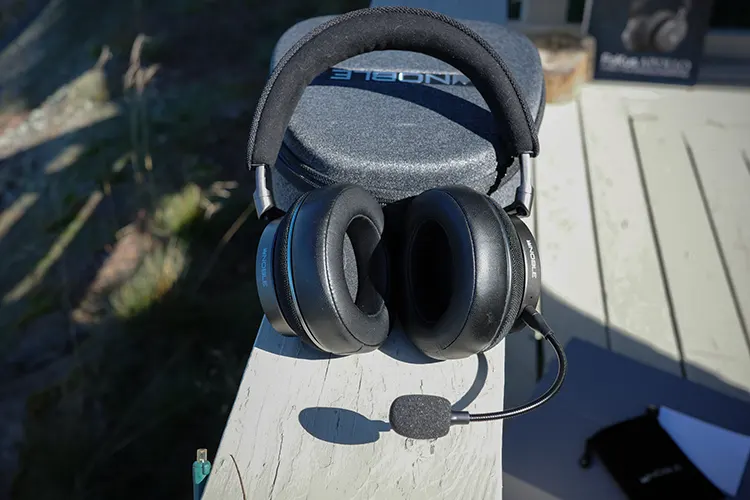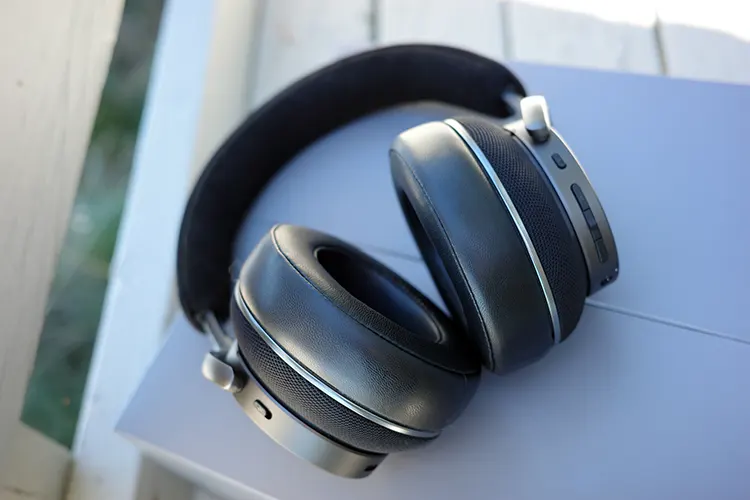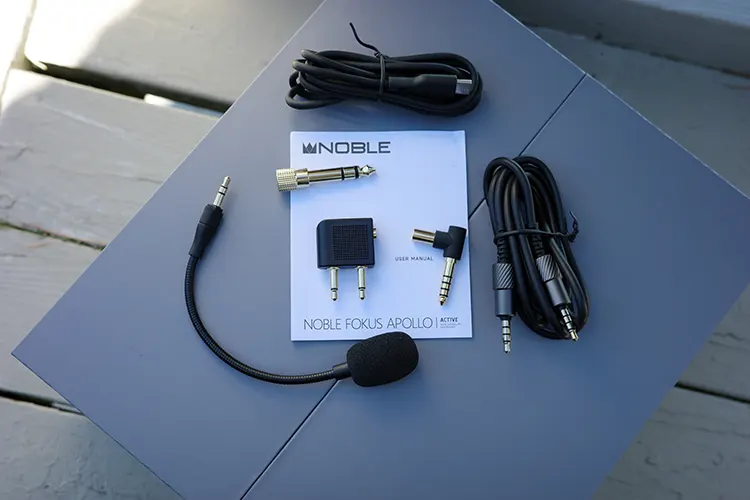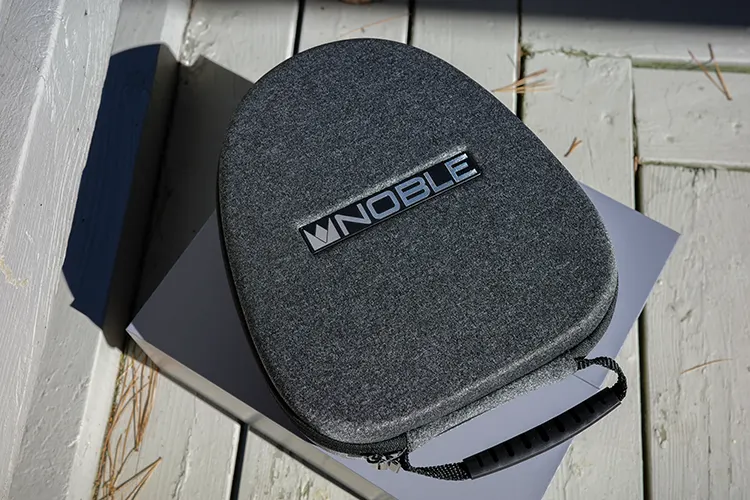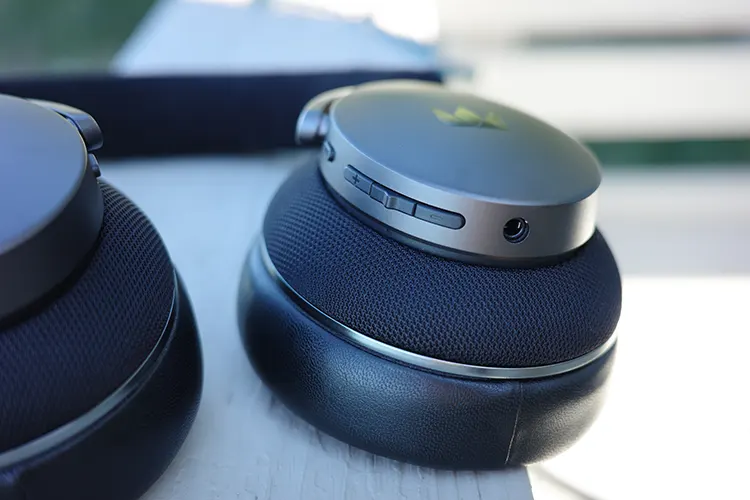Lynn reviews the Noble Audio FoKus Apollo, a hybrid 40mm dynamic and 14.5mm planar driver LDAC-capable set of wireless ANC headphones. They are priced at $649.00.
Disclaimer: This sample was sent to me in exchange for my honest opinion. Headfonics is an independent website with no affiliate links or status. I thank Noble Audio for their support.
Click here to read more about Noble Audio products we have previously featured on Headfonics.
Note that this article follows our latest scoring guidelines which you can read in more detail here.
Noble is well known for producing top-tier IEMs, including custom options. I used to own the Sultan model some time ago, and while I ended up selling it, I enjoyed its tuning a lot. Many note the “Wizard” as one of the founders of flagship IEMs.
The FoKus Apollo is Noble’s first foray into headphones and is priced at $649. It also comes with a new two-driver system, which might give it a leg up on the competition.
Purporting a top quality build, a long battery life, and excellent ANC/sound capabilities, the Apollo (hence known as) comes with the goods to muscle into the top-tier wireless headphone market.
This is where competitive models lie such as the B&W Px8 and Sony’s WH-1000XM5 (best ANC, in my opinion) as competition, and we shall see how the Apollo compares across the board.
Features
The FoKus Apollo is a set of supraural wireless hybrid driver headphones. It features a first-of-its-kind dual driver consisting of a 40mm dynamic driver coupled with a 14.5mm planar variant.
The dynamic driver handles the lows with the smaller 14.5mm planar driver mids and highs to bring the known strengths of the dynamic natural decay, weight, and planar speed and clarity into one package.
With QCC3084 BT.3 capability, the Apollo can handle a wide range of wireless codecs including LDAC, AAC, aptX, aptX HD, and SBC.
The Apollo also has hybrid noise-canceling technology consisting of microphones on both the outside and inside of the headphones. This setup combines the feedback and feedforward processes for ANC allowing for more precise and quick noise pickup.
Full ANC provides up to -35dB in isolating outside noise, without diminishing audio quality. The Apollo can also be used with the included 3.5mm cable for wired listening.
Design
My first impressions were of a premium build similar to the B&W Px8 in look and feel. The Px8 is one of the standard bearers in build quality, look, and feel so following that model is not a bad thing. The overall feel and design of the Apollo fit comfortably into that flagship role.
The frame is made of anodized aluminum with a tasteful silvery-gray finish, which combines nicely with the darker grays and black of the cups, pads, and headband.
The soft black cushy ear pads do seem to be removable, but required enough effort that I did not want to proceed any further. Combined with the black mesh pattern behind the cup, the fit and feel were very good, with excellent tactility. I never felt like the Apollo was slippery or cheap-looking, either.
The silvery-gray stanchions move into a single headband, which is wrapped in Alcantara, and with good tactility. The play in that headband was such that the Apollo formed easily to my head dimensions without too much or too little pressure.
I will note that for proper fit, I had the stanchions pulled out to within two notches of the maximum. This is the first wireless headphone that I have almost maximized for proper fit.
Control buttons lie on the right cup, and once acclimated to their proximity are easily accessible. The ANC button, which moves between open, transparency, and full-on ANC is separated enough so there isn’t confusion.
The three buttons below were equally easy to access, with the play/pause/BT connect/power on & off buttons raised for easy delineation. The left cup carried a single switch for activating the boom mic, which also attaches to that cup.
Comfort & Isolation
A premium model such as this should fit and feel the part. And, for the most part, the FoKus Apollo does.
The materials are top-notch, and the leather pads give some cushion to the fit, which is as good as it gets. Noble also made a short video on how to change pads if needed, since the company uses a fairly common mounting system.
The headband, while on the thin side, fits well while giving very good support. I appreciated the curvature of the band, which also gives excellent clamping pressure to the fit.
The cushioning aspect of the pads combined with the right amount of pressure from the headband makes long listening sessions a breeze. I could go all day without bother, and I did at least twice, accumulating at least 8 hours on the head each time.
Isolation without ANC provided good feedback to my surroundings but remained similar to other closed-back wireless headphones I have reviewed.
Battery Life
Providing up to 80 hours of uninterrupted listening without ANC, and up to 60 hours with ANC on, the Apollo sits near the top of wireless headphones. You can also listen to the 3.5mm single-ended cable and charge using the USB-C cable simultaneously.
After two complete battery drawdowns, I can confirm 60 hours with ANC (59.5 hours) and 80 for ANC off (78.5 hours). Both were a combination of BT and wired, which may moderately affect the total listening time.
Packaging & Accessories
The Apollo comes in a sleeved case, which carries the obligatory information, but does carry a higher-level feel to it in design.
Sliding off the outer sleeve, you are presented with a dual-side opening box, much like the company’s IEMs as I recall. The box has that higher-end feel, too.
Inside the box, you find the excellent case (detailed below), the Apollo, an included boom mic, a USB-C charging cable, and a 3.5mm single-ended audio cable. The obligatory user manual is included.
Carry Case
Inside the box, you find one of the best portable cases I have encountered, similar in feel to the excellent Focal cases. Instead of having a “detented” top to grasp, there is a nice grab handle on the larger end.
Sometimes those form-fitting cases can lack interior space somewhat, however, the Apollo provides the user with enough to carry all of the necessary items, including the boom mic, and both cables (USB-C charging and 3.5mm se for audio).
The look and feel of the case exude quality and tactility I appreciate it since the last thing you want is a slippery case. It is larger than its competitor’s cases, though.
I do wish for a bit more room though since the interior has a form-fitting design to hold all of the goodies in place.
An easy change would be to leave the 3.5mm cable at home, which would then give room for the charging cable and boom mic in the square indentation which lies between the slots for each headphone side.
However, if you do not plan to use the boom mic or prefer an alternative, it does come in its protective pouch.
The overall approach of the Apollo is one of luxury and a higher-end feel one has come to expect from Noble in their IEMs. It is good to see this carry over into their wireless headphones also.
Sound Impressions
Listening was done using the iPhone 13 Pro Max, MacBook Pro, and HiBy R4 with about 120+ hours of listening.
Summary
A preponderance of bass highlights a rich, full-noted signature from the FoKus Apollo.
There is a bit of bleed into the lower midrange, but this can also be construed as a deft ability to add weight to the lower mids, masking what might be considered a bloated upper bass region. That good heft down low translates into plenty of rumble when called upon.
The upper midrange and treble note deliver a distinct level of detail and clarity, that is neither too thin in weight nor too elongated in either attack or decay. A succinct character carries the top end, presenting a mostly open sound signature, that can add spatially to the character.
With a more vibrant character to it, unlike the “maturity” of the B&W Px8, you immediately recognize the strengths of the Apollo across the board.
Timbre
With a slight push forward and up in the upper midrange, there is a note of airiness to the Apollo sound signature. This lightens a smoother signature a bit while pulling the rich, warmer signature along with it.
With ANC fully engaged, I find the bass can become a bit boomy and bloat into the lower midrange but provide good weight through the attack and decay. This allows the overall signature to be musically accurate, even if a bit hefty on the note weight side.
That warmth gives the timbre depth while providing space above for the upper midrange and treble notes to provide the lift and openness I hear.
This may seem counterintuitive, but most of the time, that foundational bass clears the space for that upper-mid & treble reach. Of course, in some genres, that thumpiness to the bass can seemingly overwhelm the signature making it warmer yet.
Staging & Dynamics
The soundstage is higher than wide and deep, but neither of the three is lacking. There is a naturalness to the sound signature, that allows note weight to aid in spreading across all three dimensions.
That spreading also allows layering to meld together, overshadowing a clear delineation of the instrumental layers. This is where the whole is greater than the layers.
Punctuating treble notes respond with good dynamics, which helps to separate those layers a bit. I never found any of the parts to be lacking but do wish for a bit better micro-detail to the signature. The treble note helps, but I think a bit more would be appreciated.
Macro-details remain quite good, especially with ANC on, but the lack of micro-details can be countered a bit by using the included cable (3.5mm) or turning ANC off for a more open listen.
Connectivity
Bluetooth
With Bluetooth 5.3, I found latency to be quite good no matter what device I used. The lowest level seemed to be from my iPhone 13 Pro Max, while the HiBy R4 did struggle a bit on some videos with delay. I play this down to as much about the R4 and video, instead of the Apollo.
The initial pairing was straightforward, and it wasn’t until I realized that the Apollo would automatically connect to more than one device (after the initial connection), that I changed from connecting every time by purposely using the connect feature to simply connecting a single device.
Switching between two previously connected devices was as easy as going into your Bluetooth settings and connecting (without resetting your BT connection as I had erroneously done).
The multi-point connection was stable and easygoing between phone calls and back to the music automatically.
USB-C
Paired this way, the USB-C to USB-C still uses the DSP of the Apollo. By using the onboard chip, the quality is ensured for accurate sound production. Immediately apparent was the disparity in volume between BT and source, running in this manner.
After equalizing the volume to what I had with the BT level (by ear only), I found the sound through the USB-C to be quite extraordinary, mimicking a cabled closed-back headphone at this level.
The micro-details spoken about above became more evident (and not unexpected) and pronounced. The upper midrange push-up and forward were still there, but the added detail allowed for a more even, neutral signature. Bass became a bit more controlled as well.
Much like the Bathys or Px8, this was not unexpected and can be a very good headphone when run with a cable.
3.5mm cable
The included single-ended cable was not nearly as impressive as the USB-C. There was a lighter note quality, which was still good, with deeper reaching bass, that punctuated the signature, with a good airy quality to the signature.
However, I found it a bit thinner, and in need of much higher levels of volume to match either the Bluetooth or USB-C audio quality. The analytical quality of the 3.5mm single end was pleasant, but not as impressive as either the USB-C or BT sound qualities.
A benefit of this though is that once you completely shut the headphones down, you can still passively through the source (no DSP).
I know that the Sony WH-1000XM5 can do the same thing, and I like this aspect, which adds battery life to the headphones (not that they need it). Or, if the battery is completely dead, you can still listen. A nice feature, indeed.
While I liked the lighter signature, which helped across some genres, I preferred the USB-C cable experience a bit more.
4.4mm balanced cable
Using the included 4.4mm balanced jack, I hooked the Apollo to the HiBy R4. The Apollo automatically switches to a cabled mode, with BT disabled but ANC still functions.
What the 3.5mm lacked in note weight, the switch to 4.4mm changed to a thicker note quality. The level of detail retrieval reached nearly the same level as the USB-C, with better control of the low-end, too.
I appreciated the balanced aspect too, which makes for two very capable cable-using experiences.
Bass was still dominant but with less bleed into the midrange along with better control. The midrange did move forward more than any of the other connections, so the volume was lowered accordingly.
The ability to run BT, USB-C, or with the 4.4mm connection gives the Apollo three very versatile options; all with excellent sonic characteristics.




